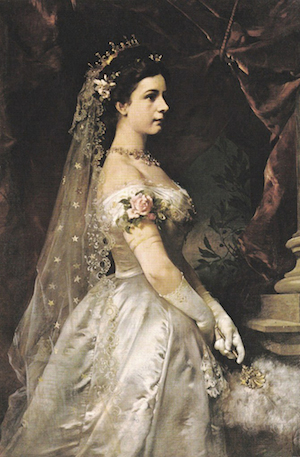Put a Strauss waltz on your iPod and warm up some apple strudel, because if you think historical fiction has explored the salacious bedrooms and board rooms of the world’s most intriguing royal families, you have yet to meet the Habsburgs. (Read Allison’s Full Article on The Huffington Post here).
 Every so often in history, a mesmeric female leader emerges who wins not only the heart of her nation but the entire world. Before there was Jackie Kennedy, before there was Princess Diana or Kate Middleton, there was a leading lady so bright, beautiful, and bold that she not only won the enduring love of her people, but changed her Empire forever. And she will be the heroine of my next novel, The Accidental Empress, a historical fiction set against the epic backdrop of the Habsburg Imperial Court.
Every so often in history, a mesmeric female leader emerges who wins not only the heart of her nation but the entire world. Before there was Jackie Kennedy, before there was Princess Diana or Kate Middleton, there was a leading lady so bright, beautiful, and bold that she not only won the enduring love of her people, but changed her Empire forever. And she will be the heroine of my next novel, The Accidental Empress, a historical fiction set against the epic backdrop of the Habsburg Imperial Court.
Following The Traitor’s Wife, with a debut and reception that exceeded my wildest expectations, I worried that I’d never find a leading lady and cast of historical characters as dramatic and captivating as the incomparable Peggy Shippen Arnold and her retinue of Benedict Arnold, John Andre, George Washington and Clara Bell. I want to tell the stories of women who shaped history and inspired people. Women who, though they occupied a time period with which people are familiar, remain less well-known. Women who have become footnotes in history when they deserve to be leading ladies.
And then I met Empress Elisabeth, known to her people simply as “Sisi.” This Empress, who presided over the Austro-Hungarian Court at the height of Habsburg power in Europe, enjoyed an almost deified status among her people. And yet, her life was one filled with heartbreak, infidelity, political turmoil, and ultimately, an untimely murder at the hands of a madman.
In a palace more lavish than Versailles, facing a court more cutthroat than Britain’s Tudors, and wielding power that outshines even the fiercest Russian Tsarinas, Sisi was plucked from obscurity to be crowned Empress of much of Europe just after her sixteenth birthday. Sisi was Europe’s ultimate celebrity, venerated in her time as “the most beautiful woman in the world.”
But there’s always more to the story, right? And that’s what makes our role as the reader of historical fiction so fun. Though Sisi’s life may appear to be a glamorous sequence of events that played out to the backdrop of Strauss waltzes and Disney-esque castles, her own personal trials and heartbreaks are deeply relatable; the greatest battles of her life occurred while trying to win and keep the love of a restless husband, earn the respect of an overbearing mother-in-law, and define her own role as a mother, an instrument of imperial power, and a brilliant and capable leader at the helm of a shifting and troubled kingdom. Of special interest to me was the way in which Sisi advocated for the Hungarians, an under-represented minority in the Austrian Empire. Given that my family has deep roots both in Hungary as well as in the Hungarian-American community in the United States, I was driven to tell this story.
Writing this novel was an adventure that allowed me to investigate the story of one of Europe’s most intriguing royal dynasties in the era when Europe’s storied monarchies were crumbling from the inside. As I traveled from Vienna’s palaces to Budapest’s cathedrals, tracing Sisi’s footsteps and the history of a nation on the eve of World War I, I uncovered an ageless truth: that real life often proves more interesting than fiction.
Interwoven into this true story are myriad characters that touched Sisi’s life long before they captured the collective imagination and earned their own places in history.
Sisi presided over the Imperial Court that gave the world the waltz. Johann Strauss II, Europe’s unrivaled “Waltz King,” composed music for his Empress that remains popular today. The other preeminent composer of the day, Franz Liszt, famously cried in the streets of Budapest when he beheld Sisi.
Sisi’s cousin, the “Mad King Ludwig,” was enamored with Sisi and welcomed her to his home, the fairy-tale castle that inspired Walt Disney’s iconic building. Sisi’s family acted as Richard Wagner’s patrons, supporting the struggling composer and ultimately positioning him to write his best-known work, the operas of The Ring Cycle.
And finally, Sisi’s heir, the Archduke Franz Ferdinand, was assassinated in Sarajevo in June of 1914, prompting the outbreak of World War I, the most disastrous conflict the world had ever known.
Sisi not only had a front row seat to history, she shaped it. I had a blast researching her and writing her, and I can’t wait for you to meet her.
This article was published by Allison Pataki in the Huffington Post




